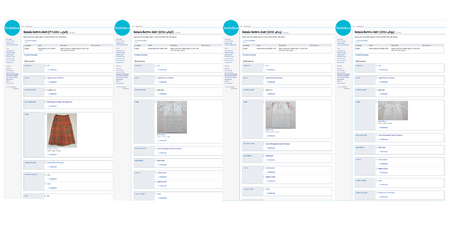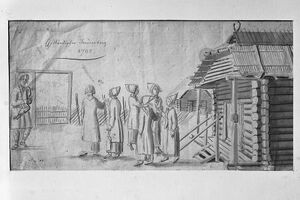Main Page
TextileBase
TextileBase is a collaborative platform for curating hard-to-find data and exploring historical clothing through linked open data in a broad interdisciplinary context. Designed for dress history scholars, museums, and practitioners, it integrates structured data and digital media from garments, illustrations, and related research sources.
🔍 Try it out! Browse garments, check source images, explore relationships between items and places—right here in our open Wikibase.
👗 Example Dataset: Latgale Garments

Explore 19th-century traditional shirts and skirts from the Latgale region in Eastern Latvia.The first published dataset, Linked Open Datasets on Garments from the Latgale Region contains data on Latvian traditional shirts and skirts from the Latgale region in Eastern Latvia. The female and male shirts, and the skirts in the dataset are handmade and were worn in the 19th century. They represent both festive and daily wear of the local female and male peasants. The shirts are stored at the National History Museum of Latvia and the Ethnographic Open-Air Museum of Latvia. The data contain information on the locality of their origin, their approximate date of creation with various precisions, the materials they are made of, and the way of their fabrication, as well as their purpose of wearing (festive or daily wear) and wearer’s ethnicity and gender. They also include the name of the museum each shirt is stored at, supplemented with its unique inventory number. Data on some sample shirts also include a photo of the shirt.
👚 Female and male festive and daily wear
🏛️ From collections of the National History Museum of Latvia and the Ethnographic Open-Air Museum
📍 Includes data on material, function, locality, ethnicity, gender, and more
▶️ Sample entries: Q142, Q180, Q179, Q181.
🔗 All Items | ListProperties
🎯 What TextileBase Offers
- Linked open data about garments, textile-related artefacts, and secondary sources
- Structured metadata on material, technique, wear context, and museum provenance
- Multimodal previews, including photographs and drawings
- Direct links to RDF datasets, compatible with Europeana and EOSC standards; all data follow FAIR principles and are stored in RDF format (e.g., Q347.ttl).
- Cross-institutional research with Seto, Livonian, and Latgalian textile data
🔬 Experimental Features
We are currently experimenting with data federation and user-friendly research tools such as faceted search interfaces that allow users to dynamically query the database through point-and-click filters.
These features are being prototyped in the Finno-Ugric Data Sharing Space (FUDSS), a sister infrastructure to TextileBase. FUDSS places Seto and Livonian garments in the wider context of Finno-Ugric cultural research, including music, audiovisual heritage, photography, and interdisciplinary publications.
- Introduction to the Finno-Ugric Data Sharing Space 👉🏼 <https://reprex.nl/project/finnougricdataspace/>
- Landing page 👉🏾 <https://reprexbase.eu/fu/index.php?title=Main_Page>
- Experimental semantic browser 👉🏻<http://135.181.91.51:3006/en/>; we would like to develop a similar, multifunctional semantic browser similar to the Finno-Ugric Sampo in future projects.
We also work with Wikimedia Eesti on the Wikimuseum concept that allows curators or researchers working with the original collections of various organisations to present digital surrogates into virtual, cross-institutional exhibitions accompanying multi-source datasets on TextileBase.
- WikiMuseum = GLAM Wiki + Wikibase + Data Sharing Space (press the F key to start the presentation.)
- Traditional Livonian Clothing: an experimental exhibition bringing together primary and secondary sources from Estonia, Finland, and Latvia.
- Traditional Seto Clothing: an experimental exhibition bringing together primary and secondary sources from Estonia, Finland, Hungary and Latvia.
🖼️ Secondary Sources

We also host structured metadata and image previews of drawings, prints, and photographs that document traditional dress. They are important secondary sources, and they are usually found in different type of institutions and with different data curation methods; most surviving textile artefacts come from museums, but secondary sources often to be found in archives and libraries.
Examples:
- Khanty (Ostiak) ermine hunters in traditional winter clothing (color plate) (Q308) and Peasant Women in Traditional Dress from Ingria (color plate) (Q319), both taken from Illustration and Description of the Peoples and Tribes under the Benevolent Rule of the Russian Emperor Alexander (Q312)
- Estonian Peasant Dance (drawing) (Q322) and Estonian Peasant Dance (drawing reproduction) (Q321)
- Group Portrait of Johann George Schwartz, his Wife, and an Unknown Woman (drawing) (Q329) and its photographic reproduction (Q328)
🫵🏼 Getting started
- Add your publications to
TextileBase👉🏾on Zenodo - Learn about editing and making manual data enrichments and comments on
TextileBaseMediaWiki FAQ - Try it out by adding your own research dataset 👉🏼 contact form